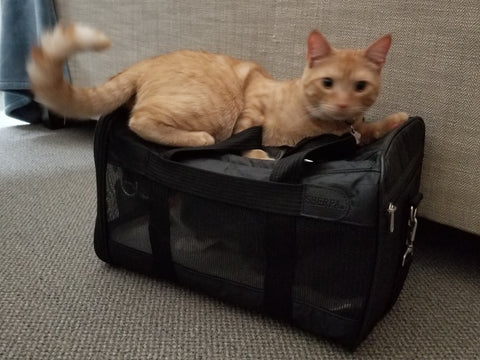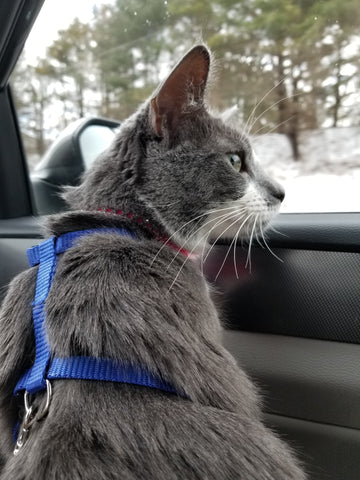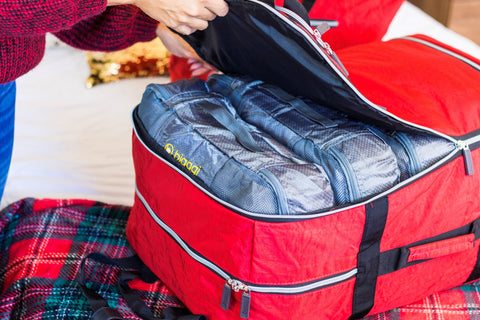Traveling with pets, or just one pet, can be a stressful situation not only for pet parents but for the fur babies as well. Whether by plane or car, one should be prepared and organized for easy pet travel.
Preparation Before Traveling with Pets
It is most important to assure a pet is healthy before heading out for a voyage. If needed one should take their pet to a veterinarian for confirmation that an elderly animal or pet with health concerns is okay to travel. The pet’s temperament is an important consideration as well.
A pet on the go should have proper identification to assure safety. Put an ID tag with cell phone number on the pet’s collar. This should be in addition to up-to-date vaccine tags. Microchipping is also an important tool to consider to protect pet from getting lost whether traveling or not. This can be done quickly and easily at a local vet or clinic without a high cost or hurt to the animal.
Just as one should have their own health information available when on the go, one should also have a copy of their animal’s medical history when traveling with pets. Not only will document show important vaccinations, like rabies, but could be helpful if needing medical attention in another state or country. One should always have with them official proof document of rabies vaccine obtained from vet.
Take photos of all pet documents to keep on phone. Send photos or scans of documents to one’s email to have in case of emergency.
Rehearse traveling with a pet before going on journey. Keep the pet crate open in the home for the animal to get used to and even use to rest their head. By taking the cat or dog on drives that are increased over time will get them ready for a longer trip.
Correct Carrier and Accessories for Pet Travel
Air travel will usually accommodate pets in cabin who are under 20 pounds. Animals over 20 pounds must be placed in the cargo area. One should plan to reserve a space for their pet as only a certain number of animals are usually allowed in the cabin, as well as cargo, and costs are usually involved.

Note that individual airlines have their own size requirements for a pet crate to be carried on board that must be followed - which is generally no larger than a medium size to fit under seat in front of passenger. Carriers should be TSA approved with a waterproof bottom, plenty of ventilation, security zippers and must fully enclose the entire pet.
One should also check if their animal is allowed to fly. Most airlines will allow dogs, cats and birds but it is important to know restrictions or else one may be turned away at the gate.
When traveling with pets the size of the carrier should allow for the animal to stand up and turn around comfortably to change position. In addition to the carrier dogs and cats should have a harness and leash. Airport security checkpoints require animals to be taken out of the carrier and it is safest to be kept on leash when going though security.
It is vital for pet travel to assure that the animal has a collar that will not get caught in carrier doors. One should clip pets nails as well to assure they do not get hooked anywhere. Make sure that both the collar and the crate have name, home address, and cell phone number for emergency. One may want to add an additional emergency contact as well when traveling.
Air Traveling with Pets In-Cabin
Along with the correct size and approved TSA carrier one should also put waterproof wee wee pads on the bottom just in case the pet needs to go and has an accident. This will allow for quick and easy cleanup.
One should try to take direct flights whenever possible to avoid flight layovers and delays causing missed connections. Before boarding try to get your dog to use the pet relief station as the pet stretches his or her legs. Have a little bag of litter in a flat Tupperware type container just large enough for the cat to use if necessary as emergency litter box.
When traveling with pets one should always have treats, toys, and food ready to entertain and feed the fur babies when waiting to board or if delayed. If possible, try to have pet swallow a treat or tiny bit of water on takeoff to prevent popping ears.
The Biaggi Liftoff Expandable Underseater is perfect for a travel companion to a pet carrier. This bag expands by pulling up the top to a carry-on size bag. When top in expanded up the compartment on the top is perfect to place pet needs along with one’s own personal items along with coat or sweater.
Safe Air Pet Travel in Cargo
In-cabin travel is not always an option when traveling with pets. For animals larger than 20 pounds one must place the pet in cargo. Check with airlines prior to planning a flight with your pet in cargo - as there are now restrictions on certain snub nosed breeds which can have breathing issues when placed in that area of the plane. One will need to book their pet for the flight as well.
Try to avoid traveling with pets in extreme heat or cold as temperatures in the cargo area fluctuate a lot during loading and unloading. During the flight the cargo hold is temperature controlled. A direct flight is safest for getting the pet as quickly and safely as possible to the destination – and make sure to be on same flight. One can request to watch pet as it is loaded and unloaded.
The pet’s cargo crate should be a sturdy plastic with a metal door, unless metal is not approved by airline. Place wee wee pads on bottom on top of bedding for waterproof comfort.
Pets should not be fed for four to six hours before trip. It is recommended to allow small amounts of water. One can also freeze water in a bowl to place inside crate during flight. This way the animal can quench thirst without water over spilling.
Upon boarding for flight passenger should alert the captain and flight crew of the animal in cargo. This way they will be extra careful to keep pressure and temperature in the cargo hole stable.
Traveling with Pets by Car
Just like humans should be secured in cars so should pets. Cats and dogs who are comfortable in carriers should stay in one with a seatbelt fastened around it. For dogs who hate their crate, there are special seat restraints made to keep them fastened in while also being able to watch the view.
Do not allow a roaming pet as this can distract the driver and cause harm to all. This also will keep the animal from sticking their head out of the window being at risk of injury by debris who illness by lungs being filled with a blast of cold air.

Try to keep the pets in the back seat if possie for pet travel. If an airbag goes off the back seat is safest to keep the fur baby from being harmed.
Enjoy some rest stops along with the pet. When traveling with pets it is important to stop and stretch everyone’s legs. See if the fur baby needs to relieve themselves as well. This is also a good time to reward good travel behavior with a treat.
Keep a tote bag just for pet needs stocked with pet bowls, food and water. Add a comfy blanket, treats and toys to keep the fur baby happy and comfy.
Be careful not to leave pet alone in car, especially in heat. When it is just a pleasant 72 F outside the inside of a vehicle can get as hot as 116 F in only an hour. In only 10 minutes a car will get to 102 F on an 85 F day. One should take the pet in arms or carrier into bathroom if possible.
Even on the shortest trips all pets should have collars with ID and emergency contact. With proper planning traveling with pets can be a pleasant experience for all.
Insert Images Courtesy of Carol Ruth Weber

 Accounts
Accounts
Comments (0)
There are no comments for this article. Be the first one to leave a message!